Systematic Review: Impact of Fat Diets on Diabetes Prevention
VerifiedAdded on 2023/01/20
|16
|3833
|91
Report
AI Summary
This systematic review investigates the impact of fat diets on the prevention of diabetes mellitus. The review analyzed ten articles, exploring the effects of various dietary approaches, including low-carbohydrate, high-fat, and plant-based diets, on blood glucose levels and diabetes management. The findings suggest that diets high in unsaturated fats and low in carbohydrates, such as plant-based diets, are effective in glycemic control and reducing the risk of developing type 2 diabetes. The review highlights the importance of dietary modifications in preventing and managing diabetes, with some studies showing significant improvements in insulin resistance and pre-diabetes risk. The quality of evidence was assessed using the GRADE approach, categorizing the studies into high, moderate, and very low grades. Despite some discrepancies, the review underscores the potential of fat-modified diets as a non-pharmacological intervention for diabetes prevention. The study also includes a detailed methodology section that discusses the search strategy, information sources, and eligibility criteria used in the review, providing a comprehensive overview of the research process and its findings.

Running head: SYSTEMATIC REVIEW
Fat diet in prevention of diabetes
Name of the Student
Name of the University
Author Note
Fat diet in prevention of diabetes
Name of the Student
Name of the University
Author Note
Paraphrase This Document
Need a fresh take? Get an instant paraphrase of this document with our AI Paraphraser
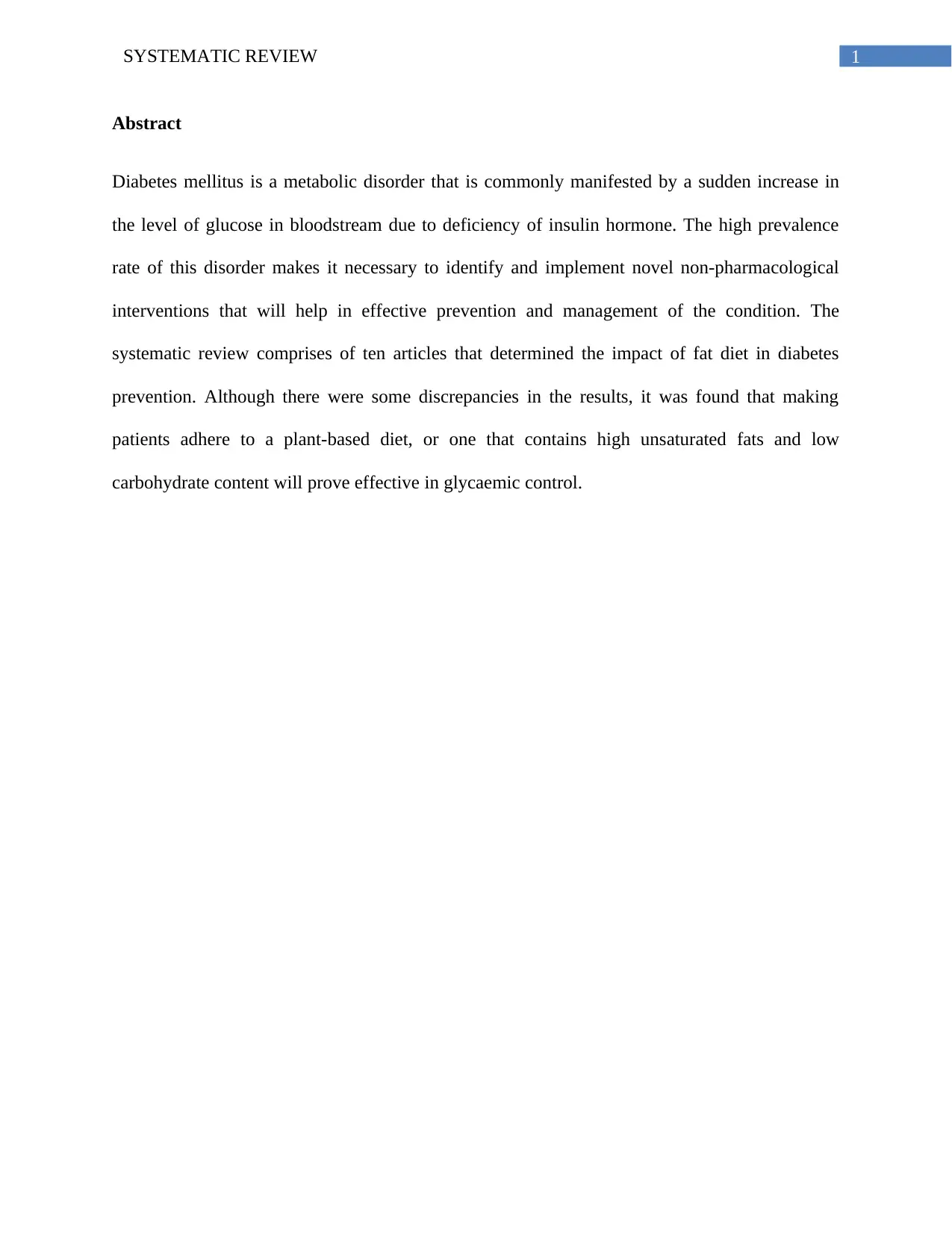
1SYSTEMATIC REVIEW
Abstract
Diabetes mellitus is a metabolic disorder that is commonly manifested by a sudden increase in
the level of glucose in bloodstream due to deficiency of insulin hormone. The high prevalence
rate of this disorder makes it necessary to identify and implement novel non-pharmacological
interventions that will help in effective prevention and management of the condition. The
systematic review comprises of ten articles that determined the impact of fat diet in diabetes
prevention. Although there were some discrepancies in the results, it was found that making
patients adhere to a plant-based diet, or one that contains high unsaturated fats and low
carbohydrate content will prove effective in glycaemic control.
Abstract
Diabetes mellitus is a metabolic disorder that is commonly manifested by a sudden increase in
the level of glucose in bloodstream due to deficiency of insulin hormone. The high prevalence
rate of this disorder makes it necessary to identify and implement novel non-pharmacological
interventions that will help in effective prevention and management of the condition. The
systematic review comprises of ten articles that determined the impact of fat diet in diabetes
prevention. Although there were some discrepancies in the results, it was found that making
patients adhere to a plant-based diet, or one that contains high unsaturated fats and low
carbohydrate content will prove effective in glycaemic control.
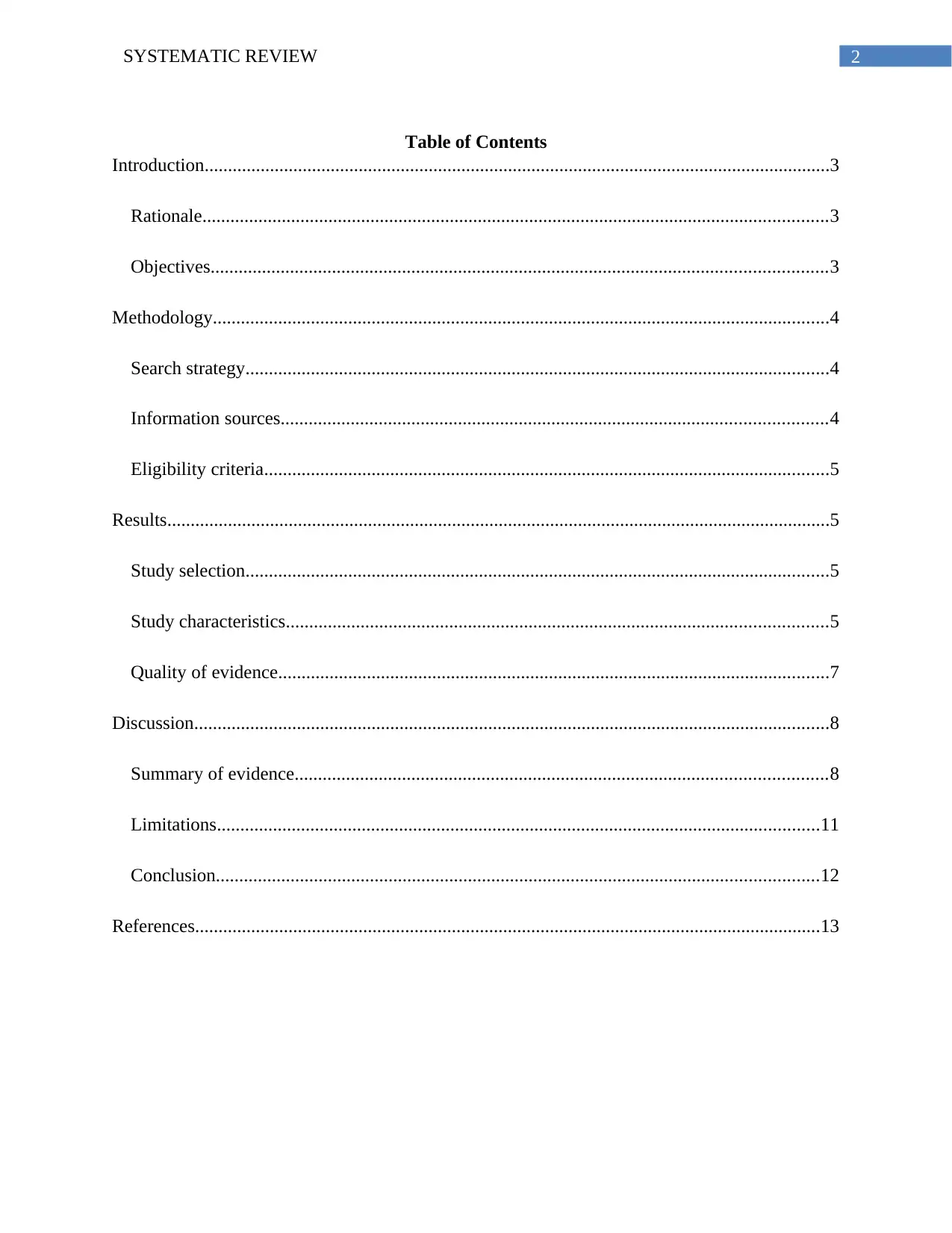
2SYSTEMATIC REVIEW
Table of Contents
Introduction......................................................................................................................................3
Rationale......................................................................................................................................3
Objectives....................................................................................................................................3
Methodology....................................................................................................................................4
Search strategy.............................................................................................................................4
Information sources.....................................................................................................................4
Eligibility criteria.........................................................................................................................5
Results..............................................................................................................................................5
Study selection.............................................................................................................................5
Study characteristics....................................................................................................................5
Quality of evidence......................................................................................................................7
Discussion........................................................................................................................................8
Summary of evidence..................................................................................................................8
Limitations.................................................................................................................................11
Conclusion.................................................................................................................................12
References......................................................................................................................................13
Table of Contents
Introduction......................................................................................................................................3
Rationale......................................................................................................................................3
Objectives....................................................................................................................................3
Methodology....................................................................................................................................4
Search strategy.............................................................................................................................4
Information sources.....................................................................................................................4
Eligibility criteria.........................................................................................................................5
Results..............................................................................................................................................5
Study selection.............................................................................................................................5
Study characteristics....................................................................................................................5
Quality of evidence......................................................................................................................7
Discussion........................................................................................................................................8
Summary of evidence..................................................................................................................8
Limitations.................................................................................................................................11
Conclusion.................................................................................................................................12
References......................................................................................................................................13
⊘ This is a preview!⊘
Do you want full access?
Subscribe today to unlock all pages.

Trusted by 1+ million students worldwide
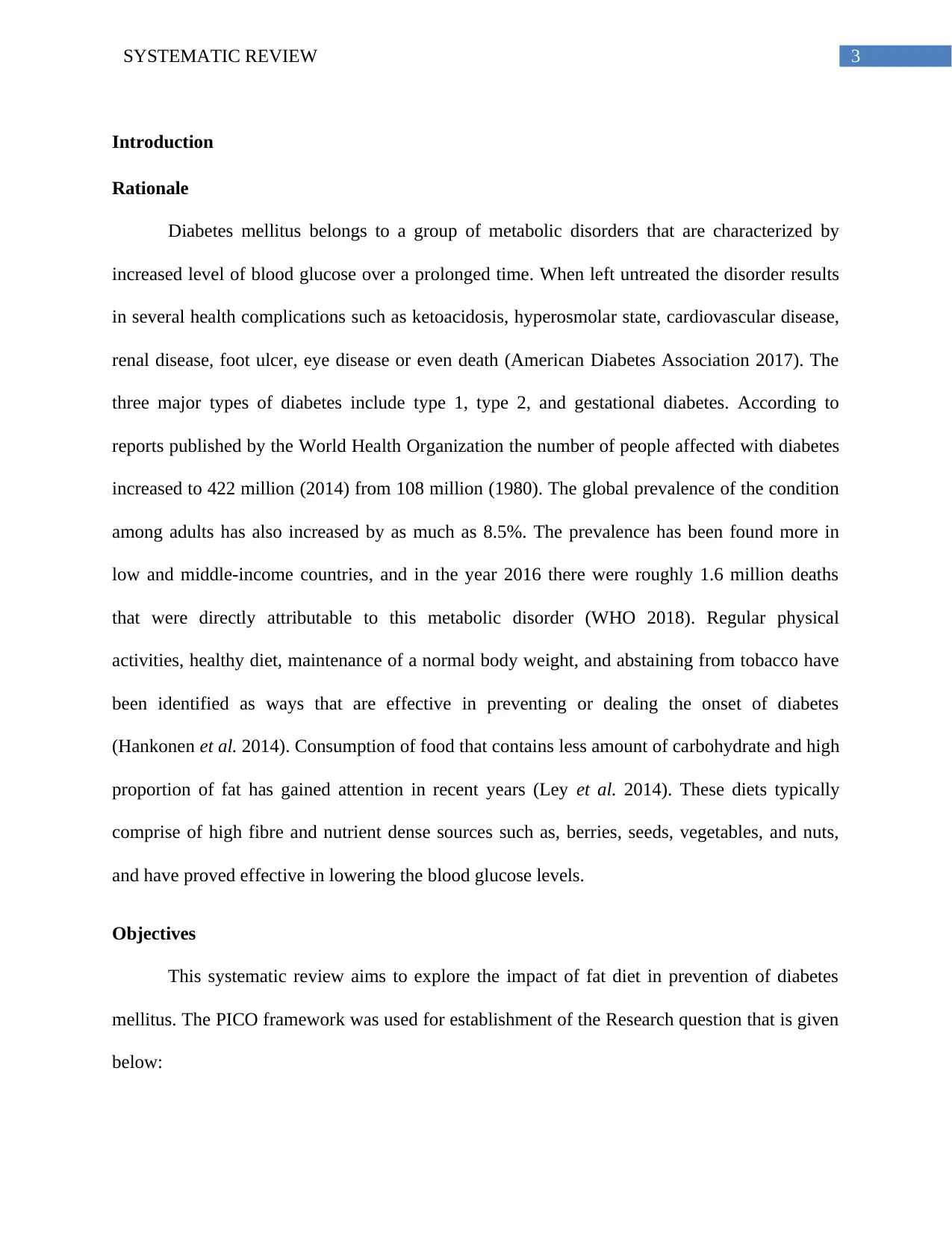
3SYSTEMATIC REVIEW
Introduction
Rationale
Diabetes mellitus belongs to a group of metabolic disorders that are characterized by
increased level of blood glucose over a prolonged time. When left untreated the disorder results
in several health complications such as ketoacidosis, hyperosmolar state, cardiovascular disease,
renal disease, foot ulcer, eye disease or even death (American Diabetes Association 2017). The
three major types of diabetes include type 1, type 2, and gestational diabetes. According to
reports published by the World Health Organization the number of people affected with diabetes
increased to 422 million (2014) from 108 million (1980). The global prevalence of the condition
among adults has also increased by as much as 8.5%. The prevalence has been found more in
low and middle-income countries, and in the year 2016 there were roughly 1.6 million deaths
that were directly attributable to this metabolic disorder (WHO 2018). Regular physical
activities, healthy diet, maintenance of a normal body weight, and abstaining from tobacco have
been identified as ways that are effective in preventing or dealing the onset of diabetes
(Hankonen et al. 2014). Consumption of food that contains less amount of carbohydrate and high
proportion of fat has gained attention in recent years (Ley et al. 2014). These diets typically
comprise of high fibre and nutrient dense sources such as, berries, seeds, vegetables, and nuts,
and have proved effective in lowering the blood glucose levels.
Objectives
This systematic review aims to explore the impact of fat diet in prevention of diabetes
mellitus. The PICO framework was used for establishment of the Research question that is given
below:
Introduction
Rationale
Diabetes mellitus belongs to a group of metabolic disorders that are characterized by
increased level of blood glucose over a prolonged time. When left untreated the disorder results
in several health complications such as ketoacidosis, hyperosmolar state, cardiovascular disease,
renal disease, foot ulcer, eye disease or even death (American Diabetes Association 2017). The
three major types of diabetes include type 1, type 2, and gestational diabetes. According to
reports published by the World Health Organization the number of people affected with diabetes
increased to 422 million (2014) from 108 million (1980). The global prevalence of the condition
among adults has also increased by as much as 8.5%. The prevalence has been found more in
low and middle-income countries, and in the year 2016 there were roughly 1.6 million deaths
that were directly attributable to this metabolic disorder (WHO 2018). Regular physical
activities, healthy diet, maintenance of a normal body weight, and abstaining from tobacco have
been identified as ways that are effective in preventing or dealing the onset of diabetes
(Hankonen et al. 2014). Consumption of food that contains less amount of carbohydrate and high
proportion of fat has gained attention in recent years (Ley et al. 2014). These diets typically
comprise of high fibre and nutrient dense sources such as, berries, seeds, vegetables, and nuts,
and have proved effective in lowering the blood glucose levels.
Objectives
This systematic review aims to explore the impact of fat diet in prevention of diabetes
mellitus. The PICO framework was used for establishment of the Research question that is given
below:
Paraphrase This Document
Need a fresh take? Get an instant paraphrase of this document with our AI Paraphraser

4SYSTEMATIC REVIEW
P Diabetes adults
I Fat changes in diet
C Normal diet
O Lower blood glucose levels
Table 1- PICO framework
The research question for the systematic review is:
What is the impact of fat diet in the prevention of diabetes mellitus?
Methodology
Search strategy
Conduction of the systematic review comprised of performing a comprehensive search in
several electronic databases, in order to extract scientific evidences that were related to the
research phenomenon under investigation. Following formulation of the research question with
the use of appropriate keywords, the aims and objectives were designed in a way that helped in
recognizing the key terms and search phrases, entered in the electronic databases (McGowan et
al. 2016). Search terms used for the systematic review were interchangeable and were namely
“diabetes”, “diabetes mellitus”, “T2D”, “gestational diabetes”, “low carbohydrate diet”, “high fat
diet”, “plant-based diet”, “vegetarian diet”, “insulin resistance”, “polyunsaturated fat”, “dietary
pattern”, “glycaemic control”, “management”, and “prevention”.
Information sources
The systematic review was conducted in three electronic databases namely PubMed,
CINAHL (Cumulative Index to Nursing and Allied Health Literature), and MEDLINE (Medical
Literature Analysis and Retrieval System Online). The reference list and bibliography of the
P Diabetes adults
I Fat changes in diet
C Normal diet
O Lower blood glucose levels
Table 1- PICO framework
The research question for the systematic review is:
What is the impact of fat diet in the prevention of diabetes mellitus?
Methodology
Search strategy
Conduction of the systematic review comprised of performing a comprehensive search in
several electronic databases, in order to extract scientific evidences that were related to the
research phenomenon under investigation. Following formulation of the research question with
the use of appropriate keywords, the aims and objectives were designed in a way that helped in
recognizing the key terms and search phrases, entered in the electronic databases (McGowan et
al. 2016). Search terms used for the systematic review were interchangeable and were namely
“diabetes”, “diabetes mellitus”, “T2D”, “gestational diabetes”, “low carbohydrate diet”, “high fat
diet”, “plant-based diet”, “vegetarian diet”, “insulin resistance”, “polyunsaturated fat”, “dietary
pattern”, “glycaemic control”, “management”, and “prevention”.
Information sources
The systematic review was conducted in three electronic databases namely PubMed,
CINAHL (Cumulative Index to Nursing and Allied Health Literature), and MEDLINE (Medical
Literature Analysis and Retrieval System Online). The reference list and bibliography of the
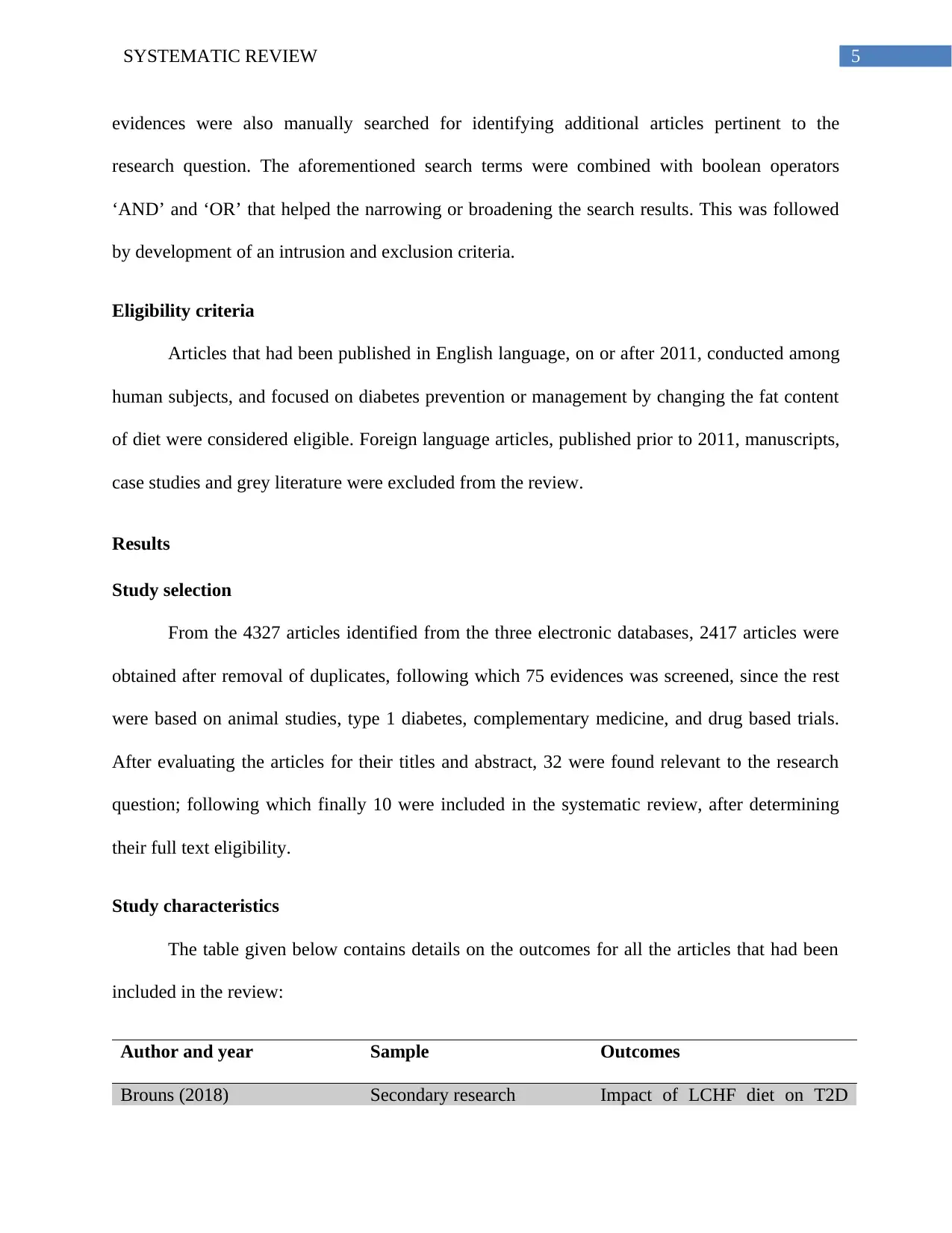
5SYSTEMATIC REVIEW
evidences were also manually searched for identifying additional articles pertinent to the
research question. The aforementioned search terms were combined with boolean operators
‘AND’ and ‘OR’ that helped the narrowing or broadening the search results. This was followed
by development of an intrusion and exclusion criteria.
Eligibility criteria
Articles that had been published in English language, on or after 2011, conducted among
human subjects, and focused on diabetes prevention or management by changing the fat content
of diet were considered eligible. Foreign language articles, published prior to 2011, manuscripts,
case studies and grey literature were excluded from the review.
Results
Study selection
From the 4327 articles identified from the three electronic databases, 2417 articles were
obtained after removal of duplicates, following which 75 evidences was screened, since the rest
were based on animal studies, type 1 diabetes, complementary medicine, and drug based trials.
After evaluating the articles for their titles and abstract, 32 were found relevant to the research
question; following which finally 10 were included in the systematic review, after determining
their full text eligibility.
Study characteristics
The table given below contains details on the outcomes for all the articles that had been
included in the review:
Author and year Sample Outcomes
Brouns (2018) Secondary research Impact of LCHF diet on T2D
evidences were also manually searched for identifying additional articles pertinent to the
research question. The aforementioned search terms were combined with boolean operators
‘AND’ and ‘OR’ that helped the narrowing or broadening the search results. This was followed
by development of an intrusion and exclusion criteria.
Eligibility criteria
Articles that had been published in English language, on or after 2011, conducted among
human subjects, and focused on diabetes prevention or management by changing the fat content
of diet were considered eligible. Foreign language articles, published prior to 2011, manuscripts,
case studies and grey literature were excluded from the review.
Results
Study selection
From the 4327 articles identified from the three electronic databases, 2417 articles were
obtained after removal of duplicates, following which 75 evidences was screened, since the rest
were based on animal studies, type 1 diabetes, complementary medicine, and drug based trials.
After evaluating the articles for their titles and abstract, 32 were found relevant to the research
question; following which finally 10 were included in the systematic review, after determining
their full text eligibility.
Study characteristics
The table given below contains details on the outcomes for all the articles that had been
included in the review:
Author and year Sample Outcomes
Brouns (2018) Secondary research Impact of LCHF diet on T2D
⊘ This is a preview!⊘
Do you want full access?
Subscribe today to unlock all pages.

Trusted by 1+ million students worldwide
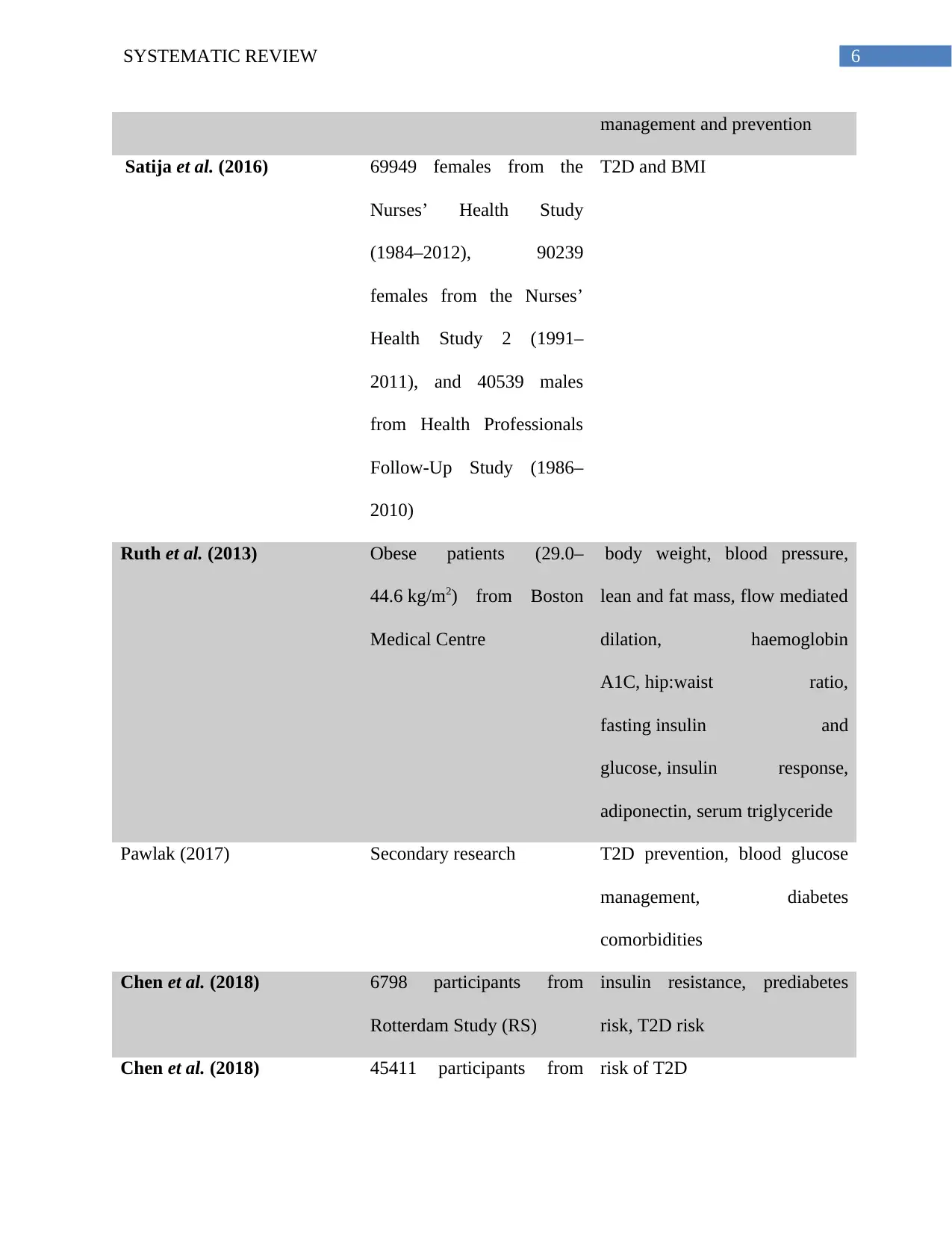
6SYSTEMATIC REVIEW
management and prevention
Satija et al. (2016) 69949 females from the
Nurses’ Health Study
(1984–2012), 90239
females from the Nurses’
Health Study 2 (1991–
2011), and 40539 males
from Health Professionals
Follow-Up Study (1986–
2010)
T2D and BMI
Ruth et al. (2013) Obese patients (29.0–
44.6 kg/m2) from Boston
Medical Centre
body weight, blood pressure,
lean and fat mass, flow mediated
dilation, haemoglobin
A1C, hip:waist ratio,
fasting insulin and
glucose, insulin response,
adiponectin, serum triglyceride
Pawlak (2017) Secondary research T2D prevention, blood glucose
management, diabetes
comorbidities
Chen et al. (2018) 6798 participants from
Rotterdam Study (RS)
insulin resistance, prediabetes
risk, T2D risk
Chen et al. (2018) 45411 participants from risk of T2D
management and prevention
Satija et al. (2016) 69949 females from the
Nurses’ Health Study
(1984–2012), 90239
females from the Nurses’
Health Study 2 (1991–
2011), and 40539 males
from Health Professionals
Follow-Up Study (1986–
2010)
T2D and BMI
Ruth et al. (2013) Obese patients (29.0–
44.6 kg/m2) from Boston
Medical Centre
body weight, blood pressure,
lean and fat mass, flow mediated
dilation, haemoglobin
A1C, hip:waist ratio,
fasting insulin and
glucose, insulin response,
adiponectin, serum triglyceride
Pawlak (2017) Secondary research T2D prevention, blood glucose
management, diabetes
comorbidities
Chen et al. (2018) 6798 participants from
Rotterdam Study (RS)
insulin resistance, prediabetes
risk, T2D risk
Chen et al. (2018) 45411 participants from risk of T2D
Paraphrase This Document
Need a fresh take? Get an instant paraphrase of this document with our AI Paraphraser
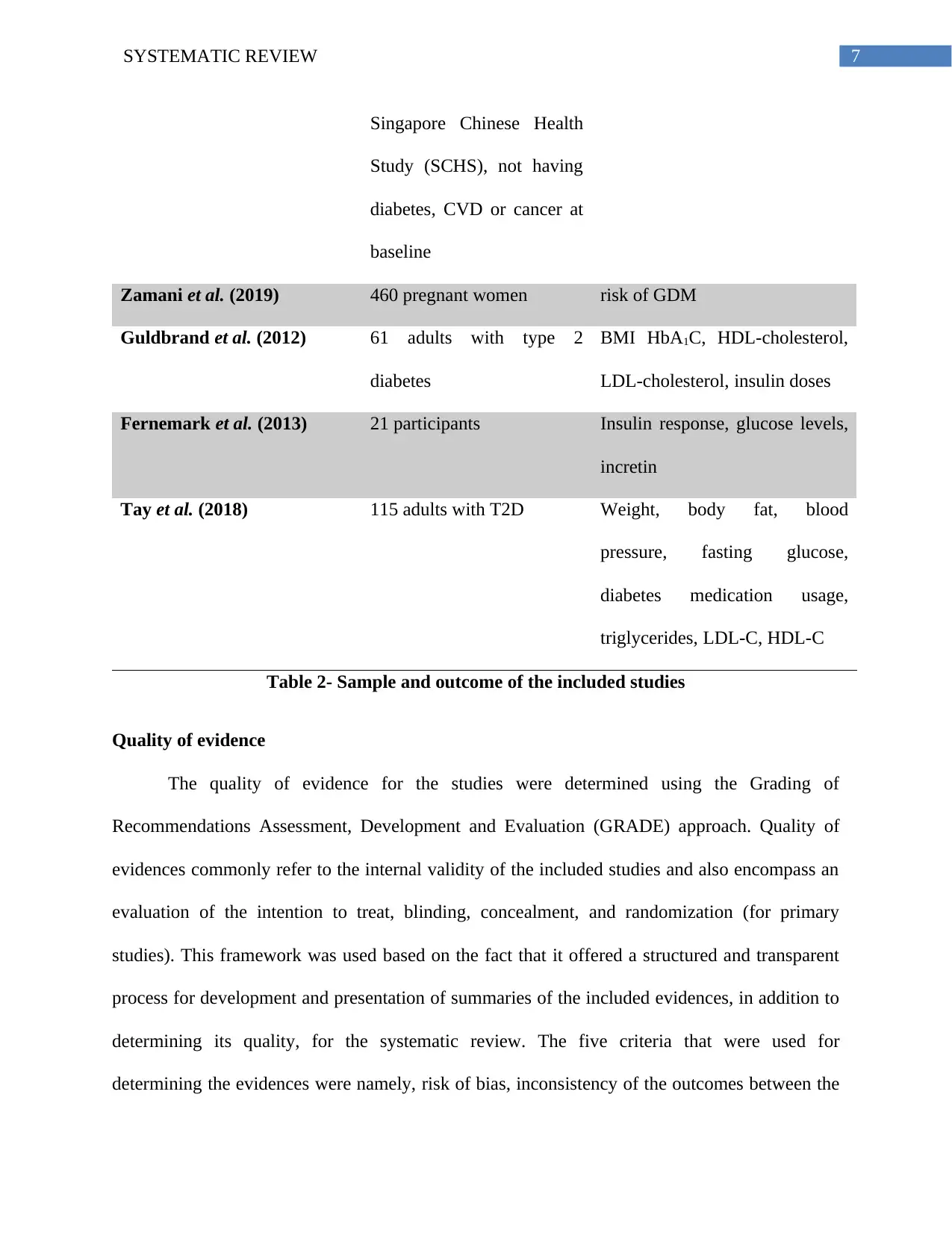
7SYSTEMATIC REVIEW
Singapore Chinese Health
Study (SCHS), not having
diabetes, CVD or cancer at
baseline
Zamani et al. (2019) 460 pregnant women risk of GDM
Guldbrand et al. (2012) 61 adults with type 2
diabetes
BMI HbA1C, HDL-cholesterol,
LDL-cholesterol, insulin doses
Fernemark et al. (2013) 21 participants Insulin response, glucose levels,
incretin
Tay et al. (2018) 115 adults with T2D Weight, body fat, blood
pressure, fasting glucose,
diabetes medication usage,
triglycerides, LDL-C, HDL-C
Table 2- Sample and outcome of the included studies
Quality of evidence
The quality of evidence for the studies were determined using the Grading of
Recommendations Assessment, Development and Evaluation (GRADE) approach. Quality of
evidences commonly refer to the internal validity of the included studies and also encompass an
evaluation of the intention to treat, blinding, concealment, and randomization (for primary
studies). This framework was used based on the fact that it offered a structured and transparent
process for development and presentation of summaries of the included evidences, in addition to
determining its quality, for the systematic review. The five criteria that were used for
determining the evidences were namely, risk of bias, inconsistency of the outcomes between the
Singapore Chinese Health
Study (SCHS), not having
diabetes, CVD or cancer at
baseline
Zamani et al. (2019) 460 pregnant women risk of GDM
Guldbrand et al. (2012) 61 adults with type 2
diabetes
BMI HbA1C, HDL-cholesterol,
LDL-cholesterol, insulin doses
Fernemark et al. (2013) 21 participants Insulin response, glucose levels,
incretin
Tay et al. (2018) 115 adults with T2D Weight, body fat, blood
pressure, fasting glucose,
diabetes medication usage,
triglycerides, LDL-C, HDL-C
Table 2- Sample and outcome of the included studies
Quality of evidence
The quality of evidence for the studies were determined using the Grading of
Recommendations Assessment, Development and Evaluation (GRADE) approach. Quality of
evidences commonly refer to the internal validity of the included studies and also encompass an
evaluation of the intention to treat, blinding, concealment, and randomization (for primary
studies). This framework was used based on the fact that it offered a structured and transparent
process for development and presentation of summaries of the included evidences, in addition to
determining its quality, for the systematic review. The five criteria that were used for
determining the evidences were namely, risk of bias, inconsistency of the outcomes between the

8SYSTEMATIC REVIEW
included studies, indirectness of evidences, publication bias, and imprecision (Gopalakrishna et
al. 2014). Based on these parameters, the studies were graded into four different categories
namely, (i) high, (ii) moderate, (iii) low and (iv) very low. In addition, the factors that were
considered to improve the quality of the collected evidence were a large magnitude effect, dose
response gradient, and plausible confounding of variables. The table provided below shows the
quality of evidence of the studies that had been included in the systematic review.
Grade Studies
High Brouns (2018), Satija et al. (2016), Pawlak
(2017), Chen et al. (2018), Chen et al. (2018),
Zamani et al. (2019)
Moderate Tay et al. (2018), Guldbrand et al. (2012),
Guldbrand et al. (2012)
Very low Ruth et al. (2013)
Table 3- GRADE quality of evidence
Discussion
Summary of evidence
Brouns (2018) provided the evidence that significant reduction in the proportion of
carbohydrate present in a diet was simultaneous with an increase in the fat content that creates an
impact on the overall quality of diet, and results in substantial weight loss. The strength of the
research can be accredited to the fact that although short term implication of LCHF diet of were
found to bring about both less desirable as well as favourable effects, maintaining a
comparatively carbohydrate low and fat rich diet in the form of a lifestyle intervention, reduces
the risk of people from developing T2D. Satija et al. (2016) also affirmed the findings of the
included studies, indirectness of evidences, publication bias, and imprecision (Gopalakrishna et
al. 2014). Based on these parameters, the studies were graded into four different categories
namely, (i) high, (ii) moderate, (iii) low and (iv) very low. In addition, the factors that were
considered to improve the quality of the collected evidence were a large magnitude effect, dose
response gradient, and plausible confounding of variables. The table provided below shows the
quality of evidence of the studies that had been included in the systematic review.
Grade Studies
High Brouns (2018), Satija et al. (2016), Pawlak
(2017), Chen et al. (2018), Chen et al. (2018),
Zamani et al. (2019)
Moderate Tay et al. (2018), Guldbrand et al. (2012),
Guldbrand et al. (2012)
Very low Ruth et al. (2013)
Table 3- GRADE quality of evidence
Discussion
Summary of evidence
Brouns (2018) provided the evidence that significant reduction in the proportion of
carbohydrate present in a diet was simultaneous with an increase in the fat content that creates an
impact on the overall quality of diet, and results in substantial weight loss. The strength of the
research can be accredited to the fact that although short term implication of LCHF diet of were
found to bring about both less desirable as well as favourable effects, maintaining a
comparatively carbohydrate low and fat rich diet in the form of a lifestyle intervention, reduces
the risk of people from developing T2D. Satija et al. (2016) also affirmed the findings of the
⊘ This is a preview!⊘
Do you want full access?
Subscribe today to unlock all pages.

Trusted by 1+ million students worldwide
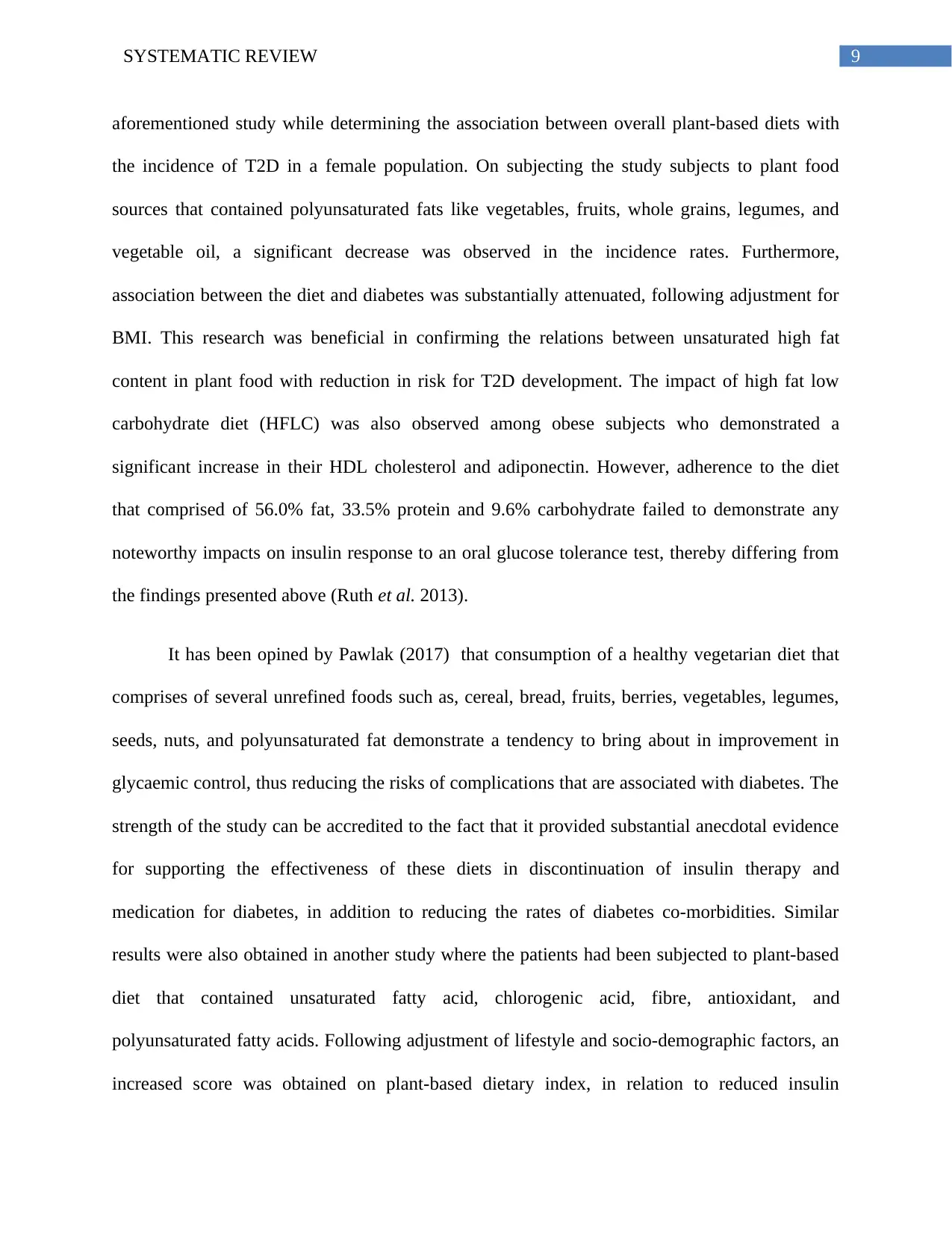
9SYSTEMATIC REVIEW
aforementioned study while determining the association between overall plant-based diets with
the incidence of T2D in a female population. On subjecting the study subjects to plant food
sources that contained polyunsaturated fats like vegetables, fruits, whole grains, legumes, and
vegetable oil, a significant decrease was observed in the incidence rates. Furthermore,
association between the diet and diabetes was substantially attenuated, following adjustment for
BMI. This research was beneficial in confirming the relations between unsaturated high fat
content in plant food with reduction in risk for T2D development. The impact of high fat low
carbohydrate diet (HFLC) was also observed among obese subjects who demonstrated a
significant increase in their HDL cholesterol and adiponectin. However, adherence to the diet
that comprised of 56.0% fat, 33.5% protein and 9.6% carbohydrate failed to demonstrate any
noteworthy impacts on insulin response to an oral glucose tolerance test, thereby differing from
the findings presented above (Ruth et al. 2013).
It has been opined by Pawlak (2017) that consumption of a healthy vegetarian diet that
comprises of several unrefined foods such as, cereal, bread, fruits, berries, vegetables, legumes,
seeds, nuts, and polyunsaturated fat demonstrate a tendency to bring about in improvement in
glycaemic control, thus reducing the risks of complications that are associated with diabetes. The
strength of the study can be accredited to the fact that it provided substantial anecdotal evidence
for supporting the effectiveness of these diets in discontinuation of insulin therapy and
medication for diabetes, in addition to reducing the rates of diabetes co-morbidities. Similar
results were also obtained in another study where the patients had been subjected to plant-based
diet that contained unsaturated fatty acid, chlorogenic acid, fibre, antioxidant, and
polyunsaturated fatty acids. Following adjustment of lifestyle and socio-demographic factors, an
increased score was obtained on plant-based dietary index, in relation to reduced insulin
aforementioned study while determining the association between overall plant-based diets with
the incidence of T2D in a female population. On subjecting the study subjects to plant food
sources that contained polyunsaturated fats like vegetables, fruits, whole grains, legumes, and
vegetable oil, a significant decrease was observed in the incidence rates. Furthermore,
association between the diet and diabetes was substantially attenuated, following adjustment for
BMI. This research was beneficial in confirming the relations between unsaturated high fat
content in plant food with reduction in risk for T2D development. The impact of high fat low
carbohydrate diet (HFLC) was also observed among obese subjects who demonstrated a
significant increase in their HDL cholesterol and adiponectin. However, adherence to the diet
that comprised of 56.0% fat, 33.5% protein and 9.6% carbohydrate failed to demonstrate any
noteworthy impacts on insulin response to an oral glucose tolerance test, thereby differing from
the findings presented above (Ruth et al. 2013).
It has been opined by Pawlak (2017) that consumption of a healthy vegetarian diet that
comprises of several unrefined foods such as, cereal, bread, fruits, berries, vegetables, legumes,
seeds, nuts, and polyunsaturated fat demonstrate a tendency to bring about in improvement in
glycaemic control, thus reducing the risks of complications that are associated with diabetes. The
strength of the study can be accredited to the fact that it provided substantial anecdotal evidence
for supporting the effectiveness of these diets in discontinuation of insulin therapy and
medication for diabetes, in addition to reducing the rates of diabetes co-morbidities. Similar
results were also obtained in another study where the patients had been subjected to plant-based
diet that contained unsaturated fatty acid, chlorogenic acid, fibre, antioxidant, and
polyunsaturated fatty acids. Following adjustment of lifestyle and socio-demographic factors, an
increased score was obtained on plant-based dietary index, in relation to reduced insulin
Paraphrase This Document
Need a fresh take? Get an instant paraphrase of this document with our AI Paraphraser
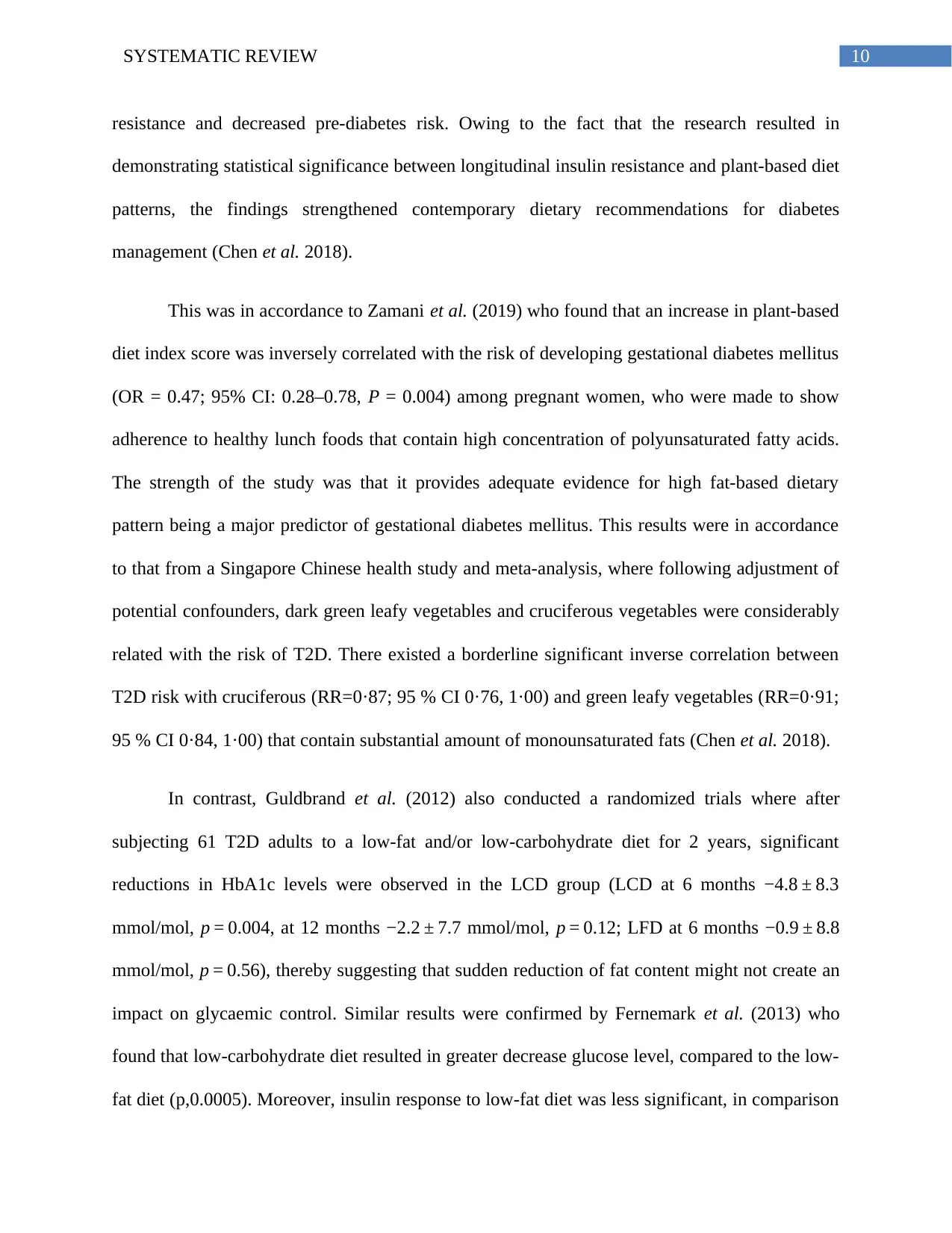
10SYSTEMATIC REVIEW
resistance and decreased pre-diabetes risk. Owing to the fact that the research resulted in
demonstrating statistical significance between longitudinal insulin resistance and plant-based diet
patterns, the findings strengthened contemporary dietary recommendations for diabetes
management (Chen et al. 2018).
This was in accordance to Zamani et al. (2019) who found that an increase in plant-based
diet index score was inversely correlated with the risk of developing gestational diabetes mellitus
(OR = 0.47; 95% CI: 0.28–0.78, P = 0.004) among pregnant women, who were made to show
adherence to healthy lunch foods that contain high concentration of polyunsaturated fatty acids.
The strength of the study was that it provides adequate evidence for high fat-based dietary
pattern being a major predictor of gestational diabetes mellitus. This results were in accordance
to that from a Singapore Chinese health study and meta-analysis, where following adjustment of
potential confounders, dark green leafy vegetables and cruciferous vegetables were considerably
related with the risk of T2D. There existed a borderline significant inverse correlation between
T2D risk with cruciferous (RR=0·87; 95 % CI 0·76, 1·00) and green leafy vegetables (RR=0·91;
95 % CI 0·84, 1·00) that contain substantial amount of monounsaturated fats (Chen et al. 2018).
In contrast, Guldbrand et al. (2012) also conducted a randomized trials where after
subjecting 61 T2D adults to a low-fat and/or low-carbohydrate diet for 2 years, significant
reductions in HbA1c levels were observed in the LCD group (LCD at 6 months −4.8 ± 8.3
mmol/mol, p = 0.004, at 12 months −2.2 ± 7.7 mmol/mol, p = 0.12; LFD at 6 months −0.9 ± 8.8
mmol/mol, p = 0.56), thereby suggesting that sudden reduction of fat content might not create an
impact on glycaemic control. Similar results were confirmed by Fernemark et al. (2013) who
found that low-carbohydrate diet resulted in greater decrease glucose level, compared to the low-
fat diet (p,0.0005). Moreover, insulin response to low-fat diet was less significant, in comparison
resistance and decreased pre-diabetes risk. Owing to the fact that the research resulted in
demonstrating statistical significance between longitudinal insulin resistance and plant-based diet
patterns, the findings strengthened contemporary dietary recommendations for diabetes
management (Chen et al. 2018).
This was in accordance to Zamani et al. (2019) who found that an increase in plant-based
diet index score was inversely correlated with the risk of developing gestational diabetes mellitus
(OR = 0.47; 95% CI: 0.28–0.78, P = 0.004) among pregnant women, who were made to show
adherence to healthy lunch foods that contain high concentration of polyunsaturated fatty acids.
The strength of the study was that it provides adequate evidence for high fat-based dietary
pattern being a major predictor of gestational diabetes mellitus. This results were in accordance
to that from a Singapore Chinese health study and meta-analysis, where following adjustment of
potential confounders, dark green leafy vegetables and cruciferous vegetables were considerably
related with the risk of T2D. There existed a borderline significant inverse correlation between
T2D risk with cruciferous (RR=0·87; 95 % CI 0·76, 1·00) and green leafy vegetables (RR=0·91;
95 % CI 0·84, 1·00) that contain substantial amount of monounsaturated fats (Chen et al. 2018).
In contrast, Guldbrand et al. (2012) also conducted a randomized trials where after
subjecting 61 T2D adults to a low-fat and/or low-carbohydrate diet for 2 years, significant
reductions in HbA1c levels were observed in the LCD group (LCD at 6 months −4.8 ± 8.3
mmol/mol, p = 0.004, at 12 months −2.2 ± 7.7 mmol/mol, p = 0.12; LFD at 6 months −0.9 ± 8.8
mmol/mol, p = 0.56), thereby suggesting that sudden reduction of fat content might not create an
impact on glycaemic control. Similar results were confirmed by Fernemark et al. (2013) who
found that low-carbohydrate diet resulted in greater decrease glucose level, compared to the low-
fat diet (p,0.0005). Moreover, insulin response to low-fat diet was less significant, in comparison
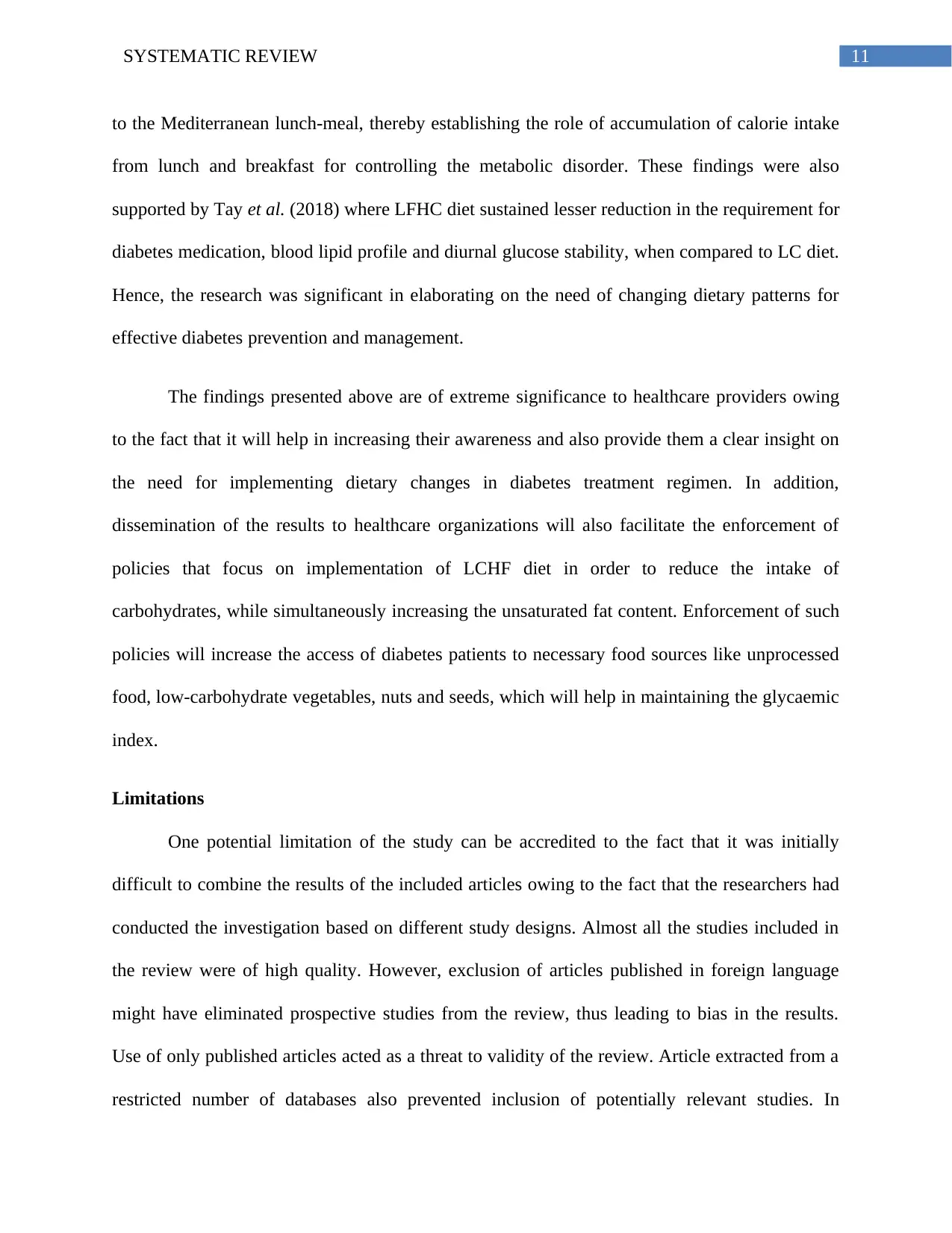
11SYSTEMATIC REVIEW
to the Mediterranean lunch-meal, thereby establishing the role of accumulation of calorie intake
from lunch and breakfast for controlling the metabolic disorder. These findings were also
supported by Tay et al. (2018) where LFHC diet sustained lesser reduction in the requirement for
diabetes medication, blood lipid profile and diurnal glucose stability, when compared to LC diet.
Hence, the research was significant in elaborating on the need of changing dietary patterns for
effective diabetes prevention and management.
The findings presented above are of extreme significance to healthcare providers owing
to the fact that it will help in increasing their awareness and also provide them a clear insight on
the need for implementing dietary changes in diabetes treatment regimen. In addition,
dissemination of the results to healthcare organizations will also facilitate the enforcement of
policies that focus on implementation of LCHF diet in order to reduce the intake of
carbohydrates, while simultaneously increasing the unsaturated fat content. Enforcement of such
policies will increase the access of diabetes patients to necessary food sources like unprocessed
food, low-carbohydrate vegetables, nuts and seeds, which will help in maintaining the glycaemic
index.
Limitations
One potential limitation of the study can be accredited to the fact that it was initially
difficult to combine the results of the included articles owing to the fact that the researchers had
conducted the investigation based on different study designs. Almost all the studies included in
the review were of high quality. However, exclusion of articles published in foreign language
might have eliminated prospective studies from the review, thus leading to bias in the results.
Use of only published articles acted as a threat to validity of the review. Article extracted from a
restricted number of databases also prevented inclusion of potentially relevant studies. In
to the Mediterranean lunch-meal, thereby establishing the role of accumulation of calorie intake
from lunch and breakfast for controlling the metabolic disorder. These findings were also
supported by Tay et al. (2018) where LFHC diet sustained lesser reduction in the requirement for
diabetes medication, blood lipid profile and diurnal glucose stability, when compared to LC diet.
Hence, the research was significant in elaborating on the need of changing dietary patterns for
effective diabetes prevention and management.
The findings presented above are of extreme significance to healthcare providers owing
to the fact that it will help in increasing their awareness and also provide them a clear insight on
the need for implementing dietary changes in diabetes treatment regimen. In addition,
dissemination of the results to healthcare organizations will also facilitate the enforcement of
policies that focus on implementation of LCHF diet in order to reduce the intake of
carbohydrates, while simultaneously increasing the unsaturated fat content. Enforcement of such
policies will increase the access of diabetes patients to necessary food sources like unprocessed
food, low-carbohydrate vegetables, nuts and seeds, which will help in maintaining the glycaemic
index.
Limitations
One potential limitation of the study can be accredited to the fact that it was initially
difficult to combine the results of the included articles owing to the fact that the researchers had
conducted the investigation based on different study designs. Almost all the studies included in
the review were of high quality. However, exclusion of articles published in foreign language
might have eliminated prospective studies from the review, thus leading to bias in the results.
Use of only published articles acted as a threat to validity of the review. Article extracted from a
restricted number of databases also prevented inclusion of potentially relevant studies. In
⊘ This is a preview!⊘
Do you want full access?
Subscribe today to unlock all pages.

Trusted by 1+ million students worldwide
1 out of 16
Related Documents
Your All-in-One AI-Powered Toolkit for Academic Success.
+13062052269
info@desklib.com
Available 24*7 on WhatsApp / Email
![[object Object]](/_next/static/media/star-bottom.7253800d.svg)
Unlock your academic potential
Copyright © 2020–2025 A2Z Services. All Rights Reserved. Developed and managed by ZUCOL.





